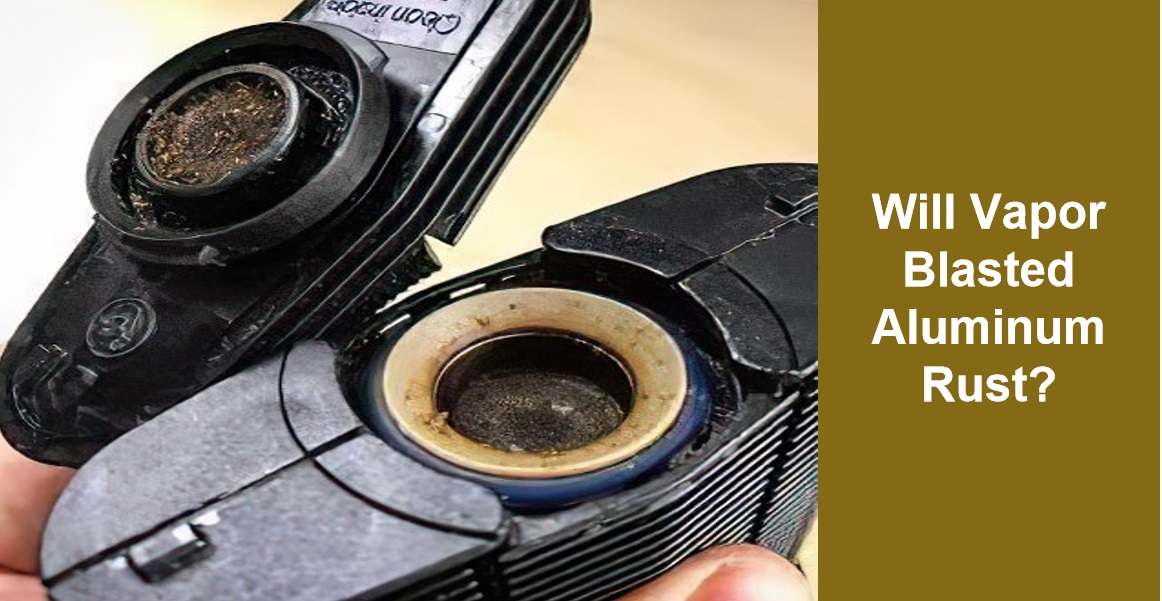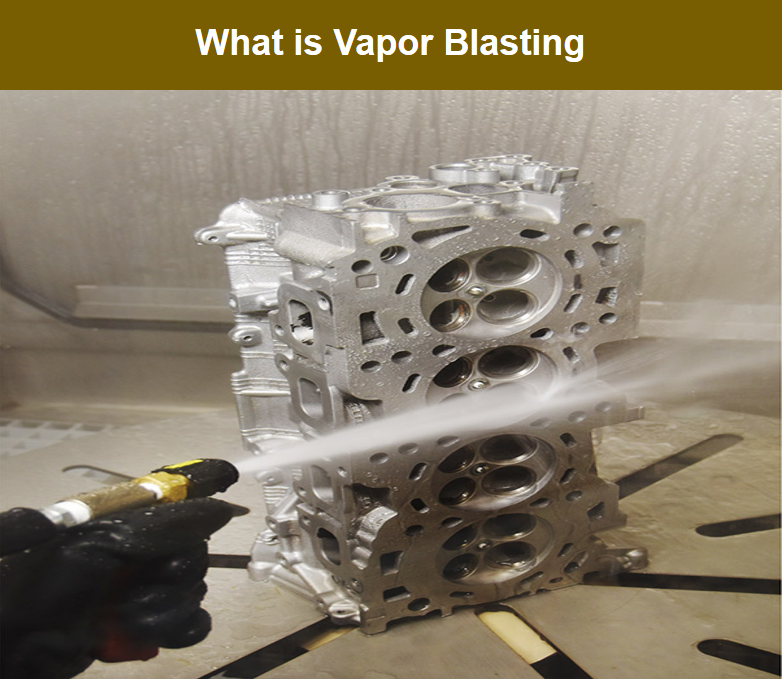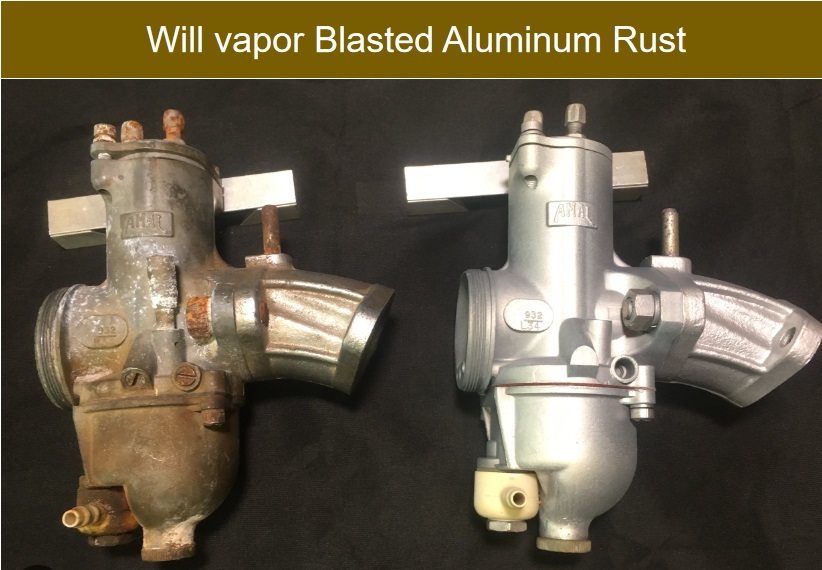Will Vapor Blasted Aluminum Rust ? Fully Explained

As we all know, aluminum as a metal is widely used in various industries due to its lightweight, durable, and corrosion-resistant properties.
When it comes to surface finishing and treatments, vapor-blasted aluminum has become a popular choice, especially in industries where vaporizers are among the hottest trends.
The accompanying question is will vapor Blasted Aluminum Rust?
This article will delve into the details of vapor blasting, aluminum corrosion, and whether vapor-blasted aluminum rust is susceptible to rusting.
What is Vapor Blasting?

Vapor blasting, also known as wet blasting or liquid honing, is a surface-finishing process that combines water, abrasive particles, and compressed air to clean and polish surfaces.
The abrasive is usually glass beads but can also be aluminum oxide for more aggressive rust & coating removal.
Unlike dry blasting, vapor blasting is a gentler process that produces a finer finish without damaging the substrate.
The water acts as a lubricant, reducing the abrasive’s impact and minimizing surface erosion.
Will Vapor Blasted Aluminum Rust?

Aluminum undergoes a process called oxidation, which forms a protective layer of aluminum oxide on its surface.
This protective layer prevents further oxidation and corrosion, making aluminum ideal for environments where moisture and oxygen are present.
Therefore aluminum will not rust, and usually done correctly, steam blasting will not damage this protective oxide layer, so the answer is that vapor blasting aluminum will not rust!
Impact of Vapor Blasting on Corrosion Resistance
Vapor blasting can enhance aluminum’s corrosion resistance by cleaning the surface and removing impurities.
However, it is essential to note that improper vapor blasting techniques or incorrect abrasives can potentially damage the oxide layer, leading to increased susceptibility to corrosion.
Factors Influencing Corrosion Resistance
Several factors can influence the corrosion resistance of will vapor-blasted aluminum rust:
Abrasive Material
The choice of abrasive material is crucial. Non-metallic abrasives are generally preferred to avoid embedding metal particles that can promote galvanic corrosion.
Water Quality
Clean, deionized water should be used in the vapor blasting process to prevent introducing impurities that could compromise corrosion resistance.
Blasting Parameters
The pressure, abrasive concentration, and nozzle distance must be carefully controlled to avoid damaging the surface.
Protection Measures
While vapor blasting enhances corrosion resistance, it is essential to take additional protective measures, especially in harsh environments:
Clear Coating
Applying a clear protective coating can provide an additional barrier against environmental factors.
Anodizing
Anodizing can further enhance the oxide layer, offering superior protection against corrosion.
Regular Maintenance
Regular cleaning and maintenance can help preserve the integrity of the vapor-blasted surface.
Benefits of Vapor Blasting
Vapor Blasting is used a lot in the industry.
It is often used on machined parts to clean or give a uniform finish without removing material.
It’s also used to clean used parts in preparation for rebuilding.
It works equally well on aluminum and ferrous metals.
Additives to the vapor blasting can inhibit rust or other corrosion.
Vapor Blasting is sometimes used on aluminum to give a uniform finish prior to anodizing and on ferrous metals before adding coatings such as paint, Teflon, etc.
Worker Safety
Dust Reduction: Vapor blasting significantly reduces hazardous dust by 95% compared to traditional sandblasting.
The water in the vapor blasting process surrounds the abrasive particles, causing them to fall to the ground instead of becoming airborne.
This makes vapor blasting a safer option, especially in environments with multiple workers and is recommended by OSHA.
Heat Reduction
Preventing Surface Damage: Dry blasting generates substantial heat due to friction, which can lead to problems like warping thin metals or cracking weak substrates.
In contrast, the water in vapor blasting keeps the blasted surface cool, helping to prevent damage to delicate materials and coatings.
Effective for Tough Coatings
Enhanced Performance: Vapor blasting excels at removing extremely tough coatings.
The inclusion of water not only suppresses dust and debris but also adds weight to the abrasive media, allowing it to strike the substrate with greater force compared to dry blasting.
Simultaneous Cleaning and Coating Removal
Dual Functionality: While dry blasting primarily focuses on coating removal, vapor blasting also serves as an effective cleaning solution.
It combines the processes of cleaning and coating removal in one step, making it a more efficient choice.
Environmental Concerns
Eco-Friendly: Vapor blasting is a more environmentally friendly option than sandblasting.
It can be easily contained, reducing the risk of airborne particles harming natural areas and plants.
This containment is especially important in marinas and other sensitive environments, where wet blasting is preferred to prevent dust from contaminating water bodies.
Can vapor blasting be used on other metals besides aluminum?
Vapor blasting is primarily used to clean and polish aluminum surfaces, enhancing their appearance and corrosion resistance.
However, steam injection can be used on a variety of metals, including steel, brass, and titanium.
However, process parameters may need to be adjusted to suit the particular material being treated.
Maintaining Vapor-Blasted Aluminum
To ensure that vapor-blasted aluminum retains its optimal appearance and performance, follow these maintenance tips:
Regular Cleaning
Consistent cleaning is crucial.
Use mild detergents and soft cloths to gently remove dirt and contaminants, avoiding any damage to the surface.
Avoid Harsh Chemicals
Steer clear of harsh chemicals or abrasive cleaners that could harm the aluminum surface or erode the protective oxide layer.
Opt for gentle cleaning agents designed for aluminum.
Protective Coatings
Applying a clear protective coating can help maintain the vapor-blasted finish and offer extra protection against environmental elements.
This is especially beneficial in marine or industrial settings.
Inspection and Maintenance
Regularly inspect the aluminum parts for signs of wear or corrosion.
Address any issues promptly to prevent further damage and extend the lifespan of the components.
Conclusion
So, Will vapor blasted aluminum rust? While aluminum itself does not rust, vapor blasting is an effective technique for improving the appearance and performance of aluminum components.
This process cleans and polishes the surface, which can enhance aluminum's natural corrosion resistance.
However, to achieve optimal results, it is crucial to employ proper techniques and apply appropriate protective measures.
By understanding the benefits and considerations of vapor blasting, you can make well-informed decisions regarding its application and up keep for your aluminum parts.
